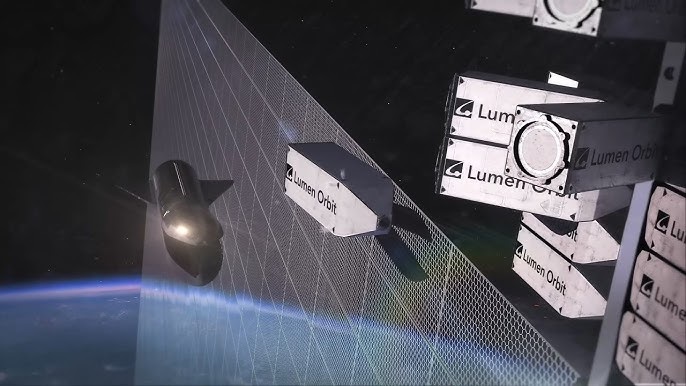
Introduction
Scott Manley discusses a white paper by Silicon Valley startup Lumen Orbit proposing to put data centers in space. The company, backed by Y Combinator (known for Reddit, Twitch, and Airbnb), suggests that space-based data centers could be more cost-effective for AI training and large compute tasks compared to terrestrial alternatives.
Data Centers in Space: A Technical Analysis of Orbit’s Proposal
Orbit, a company at the forefront of space-based data centers, has proposed a revolutionary concept: placing massive data centers in space. This approach promises to address several limitations of Earth-bound data centers, such as energy consumption, cooling, and latency. However, it also presents unique technical challenges that must be overcome.
Powering Space-Based Data Centers: Solar Energy and Beyond
Orbit’s proposal relies heavily on solar power. The company plans to deploy large solar arrays in space, capable of generating significant amounts of electricity. This approach offers several advantages:
- Abundant Energy: Space-based solar power systems can operate 24/7, unaffected by weather or day/night cycles.
- Reduced Environmental Impact: Eliminates the need for fossil fuels and reduces the carbon footprint of data centers.
However, solar power in space also faces challenges:
- Intermittency: Solar flares and eclipses can temporarily disrupt power generation.
- Energy Storage: Storing sufficient energy for periods of low solar activity remains a significant challenge.
To address these issues, Orbit plans to implement a combination of energy storage technologies, such as batteries and flywheels. Additionally, the company is exploring alternative energy sources, such as nuclear power, to provide a more reliable and continuous power supply.
Cooling Space-Based Data Centers: The Advantages of a Vacuum
One of the most significant advantages of space-based data centers is the ability to passively cool equipment using the vacuum of space. This eliminates the need for complex and energy-intensive cooling systems, which are a major source of energy consumption in traditional data centers.
However, passive cooling in space also presents challenges:
- Heat Dissipation: Efficiently transferring heat from the equipment to the surrounding environment requires careful thermal design.
- Temperature Fluctuations: Extreme temperature variations in space can affect the performance of electronic components.
Orbit plans to address these challenges by implementing advanced thermal management systems, such as heat pipes and radiators. Additionally, the company is developing specialized hardware that is more resistant to extreme temperatures.
The Role of Artificial Intelligence in Space-Based Data Centers
Artificial intelligence (AI) plays a crucial role in the operation of space-based data centers. AI algorithms can be used to:
- Optimize Energy Consumption: Predict and adjust power consumption based on demand and solar availability.
- Manage Thermal Loads: Control cooling systems to maintain optimal temperatures.
- Detect and Diagnose Faults: Identify and address equipment failures before they cause significant disruptions.
Orbit is developing AI-powered systems to manage all aspects of its space-based data centers, from power generation and cooling to fault detection and maintenance.
The Cost of Data Center in Space
The cost of building and maintaining space-based data centers is currently prohibitively high. Here’s a breakdown of the major cost factors:
- Launch Costs: Launching satellites into orbit is incredibly expensive, with costs varying depending on the size and weight of the payload and the launch vehicle used.
- Infrastructure Costs: Building and deploying large-scale solar arrays, power systems, and cooling systems in space requires significant investment in research, development, and manufacturing.
- Maintenance Costs: Servicing and repairing equipment in space is extremely challenging and costly, requiring specialized tools, techniques, and trained personnel.
- Research and Development: Ongoing research and development is necessary to overcome the technical challenges associated with space-based data centers, such as radiation shielding, thermal management, and energy storage.
While the exact cost of a space-based data center is difficult to estimate at this stage, it is safe to say that it would be significantly higher than the cost of a traditional, Earth-based data center. However, proponents of space-based data centers argue that the long-term benefits, such as reduced energy consumption and improved performance, could outweigh the initial investment costs.
Here are some potential cost-saving strategies that could be explored:
- Reusable Launch Vehicles: The development of reusable launch vehicles could significantly reduce the cost of launching satellites into orbit.
- Modular Design: Modular designs could make it easier to build and maintain space-based data centers, reducing construction and repair costs.
- Automation: Increased automation could reduce the need for human intervention, lowering maintenance costs.
- Public-Private Partnerships: Collaboration between governments and private companies could help to share the costs and risks associated with space-based data centers.
As technology continues to advance and the demand for data processing and storage grows, the cost of space-based data centers may become more competitive with traditional data centers. However, it is important to note that this is still a long-term goal, and significant technological breakthroughs are needed to make space-based data centers a viable commercial reality.
Video about Data Center in Space:
Key Technical Aspects
Power Generation
- Proposes using solar panels in space with 24/7 sun exposure
- Plans for 4km-wide solar arrays (16 square km) for 5GW data center
- Initial smaller test with 40MW system launchable on single rocket
- Solar panels in space potentially more efficient than ground-based due to lack of atmospheric interference and weather impacts
Orbital Considerations
- Requires sun-synchronous orbit at 97° inclination
- Faces challenges with orbital debris due to large solar panel size
- Higher orbits needed to reduce atmospheric drag but increase radiation exposure
- Orbital maintenance costs and requirements not fully addressed in proposal
Cooling Challenges
- Thermal radiation management crucial for space-based data centers
- Requires extensive radiator systems for heat dissipation
- Cooling system needs significant power for pumping coolant
- Earth’s thermal radiation and reflected sunlight affect cooling efficiency
Technical Limitations
- Data center nodes need close proximity for efficient communication
- Solar panel degradation from radiation exposure in higher orbits
- Launch costs and mass restrictions affect system scalability
- Complex balance between power generation and cooling requirements
Economic Analysis
- Claims $8.2M operating cost over 10 years versus $167M for terrestrial centers
- Assumes $5M launch cost for 100 tons to orbit
- Additional costs for radiation shielding and thermal management
- Higher orbit requirements may impact initial cost projections
Conclusion
Orbit’s proposal for space-based data centers represents an innovative approach to overcoming traditional data centers’ limitations. While major technical hurdles exist, the potential benefits—reduced energy consumption, improved cooling, and lower latency—are compelling. As technology advances, space-based data centers could revolutionize how we process and store information.
Though promising for future space infrastructure, the concept faces crucial technical and economic challenges. Its success hinges on solving cooling problems, managing radiation exposure, and achieving the projected launch costs.
Key Takeaways
- Space-based data centers could potentially offer power advantages over terrestrial facilities
- Cooling and radiation management present major engineering challenges
- Current cost projections may not fully account for all technical requirements
- The technology could have applications beyond AI training if successful
- Environmental impact could be favorable despite launch emissions


